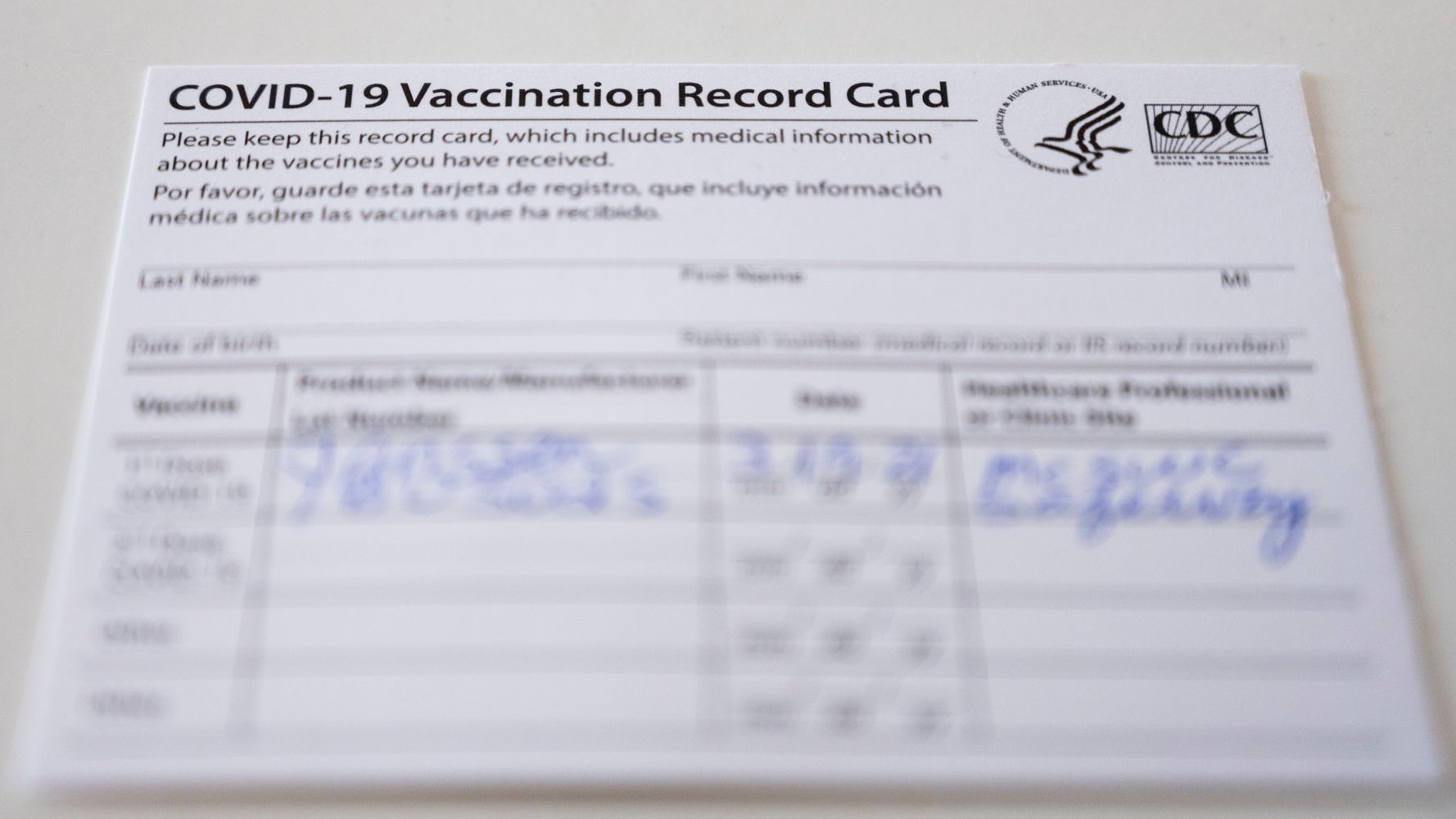As states continue to expand COVID-19 vaccine eligibility, Americans are rolling up their sleeves in record numbers. It’s estimated that 1 in 4 Americans are now fully vaccinated, which means millions are walking around with coronavirus vaccination record cards.
And those small, seemingly humble pieces of paper — issued by the Centers for Disease Control and Prevention — are pretty darn important. So here are some basics about your COVID-19 vaccine card and some tips about what you should (and shouldn’t) do with yours:
Everyone who is vaccinated should receive a vaccine record card.
At your first vaccine appointment (or your only appointment, if you receive the single-dose Johnson & Johnson vaccine), “you should get a vaccination card that tells you what COVID-19 vaccine you received, the date you received it, and where you received it,” according to the CDC.
The 4×3-inch card should say whether your vaccine was manufactured by Pfizer, Moderna or Johnson & Johnson, as well as the dose numbers. It also notes when and where you got your doses.
Having some kind of official record of the “what” and “when” is vital. For one, it helps make it really clear when you should get your second shot (if you got a two-dose vaccine). But it could also be helpful months down the road. Many experts believe that future booster shots will be necessary, both because of the rise of new COVID-19 variants and because there are still a lot of questions about how long immunity lasts. If that happens, the card will help you know when you were vaccinated the first time around.
If you did not receive a COVID-19 vaccination card at your first appointment, you should contact the vaccination site you visited or your state health department (which is tracking who receives the vaccine) to find out how you can get one.
Take a picture of your card.
The CDC recommends that once you get your vaccine card, you should snap a picture of it (front and back) as a backup copy.
In fact, consider taking a photo after each dose you receive — and make sure that photo doesn’t just live on your phone.
“Keep the picture on your phone, and email yourself a copy to be safe,” Leana Wen, an emergency physician and public health professor at George Washington University, told CNN. She also said that she recommends making a photocopy that you store with other important documents.
But DON’T post it on social media.
You may be (understandably) excited and want to share the good news of your vaccination with friends and family online. But don’t do it.
“Your vaccination card has information on it including your full name, date of birth, where you got your vaccine, and the dates you got it. When you post it to Facebook, Instagram, or to some other social media platform, you may be handing valuable information over to someone who could use it for identity theft,” warns the Federal Trade Commission.
“Just by knowing your date and place of birth, scammers sometimes can guess most of the digits of your Social Security number,” the organization noted.
Keep your vaccine card in a safe spot.
The idea of “vaccine passports” is controversial, raising all kinds of legal and ethical questions about what schools, businesses and government leaders can and cannot require in terms of vaccination. And what form those “passports” might take is also unclear. A verification app? Some other form of proof?
However, for now, you don’t really need to regularly flash your vaccination as proof of inoculation. So while you certainly can carry it in your wallet or bag, you don’t actually need to.
“At this time, you do not need to carry your CDC vaccination card with you day-to-day,” according to guidance on the Ohio State University Wexner Medical Center website. “Other than bringing it to your vaccination appointments, you can keep it in a safe location.” Experts recommend someplace secure and dry, where you store other important documents.
If you lose or damage your card ― or forget to bring it to your second appointment ― don’t fret.
If you misplace your vaccination card, either before your second appointment or after you’re fully vaccinated, don’t freak out. The CDC recommends you first contact your vaccination provider directly and they should be able to help you access your vaccination record. (If you enrolled in a program like V-Safe, the CDC’s after-vaccination health checker, you’ll be able to get your records there.)
It’s possible that the vaccine provider will be able to “recreate the card based on the data” it has available, experts have said, though the CDC doesn’t officially say anything about whether it will just hand you another replacement paper card.
If, for whatever reason, your vaccination site isn’t able to help you, the CDC says your next move should be to contact your state health department’s immunization information system. “Vaccination providers are required to report COVID-19 vaccinations to their IIS and related systems,” according to the agency.
One note of caution, however. As The Wall Street Journal reports, there isn’t actually a central, country-wide database for vaccinations. “States maintain an incomplete patchwork of records,” the publication warns. So while it’s likely you’ll be able to track down verification of your vaccination status, you really should try your best to keep your card safe and dry, and bring it with you to all your appointments.
Don’t worry about that expiration date.
The expiration date on your vaccination card doesn’t actually mean anything about how long you’ll be protected against COVID-19; it’s for vaccine administrators to know how long they have from the time the dose was bottled up and shipped until it needs to go into someone’s arm.
That’s because the vaccines can only be stored for a certain amount of time before they expire, which means they are less potent. They must also be stored and shipped according to specific instructions for that same reason.
Laminate it? It’s complicated.
Some public health officials have recommended against laminating your card, warning that it could render some cards that have been printed on thermal printer labels illegible. Others are anti-lamination in case you need boosters down the road and the card needs to be filled out more. (Though other experts note that if you do end up needing a booster down the road, it’s likely you’ll also be able to get a different card at that point.)
One less permanent alternative is to buy a clear plastic vaccine cardholder, although ultimately, experts say that if you’ve done most of the above — taken a photo and emailed it to yourself and stashed your card in a secure place — you really should be fine.
Experts are still learning about COVID-19. The information in this story is what was known or available as of publication, but guidance can change as scientists discover more about the virus. Please check the Centers for Disease Control and Prevention for the most updated recommendations.


